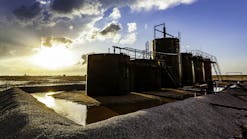A flow control loop consisting of a flowmeter, controller, and control valve is used to control the flow of a gas to a process. Measurements from a pressure transmitter installed some time ago indicate the incoming air pressure is typically two bar, but it can vary from one to 2.5 bar due to process upsets that occur upstream. How will these pressure variations affect the flow measurement, assuming the flowmeter is calibrated to operate at a typical pressure of two bar?
Commentary
First, it is the absolute pressure of the gas that is important when measuring flow. The pressure of a standard atmosphere is 1.01325 bar absolute, but to make the mathematics simpler here, we will approximate an atmosphere to be one bar absolute. Making this approximation, the typical operating pressure is three bar absolute with variations that can reach from two to 3.5 bar absolute.
Second, many gas flow measurements are inferential mass measurements in units expressed as a standard cubic volume per unit time. However, regardless of the gas pressure, raw flowmeter measurements reflect the mass, volume, velocity, or velocity head of the gas.
With regard to how these pressure variations affect the flow measurement — it depends. If the flowmeter measures mass flow, there will (in theory) be no impact on the flow measurement. That is, a mass flowmeter should not be affected by process pressure variations.
However, if the flowmeter measures volume or velocity, the effects are inversely proportional to the variation in absolute pressure. For example, if the gas were operating at a pressure of 3.5 bar absolute, its volume would be approximately 3/3.5, or 85.7 percent, of what it would be if the operating pressure were three bar absolute. As a result, the flowmeter would measure approximately 14.3 percent lower than it would if the same mass of gas were flowing at three bar absolute.
The output of flowmeters that infer mass flow by measuring the differential pressure across a restriction, such as an orifice plate, Venturi, flow nozzle, and the like, is also inversely affected by variations in operating pressure. However, the relationship is not one-to-one, as in the case of flowmeters that measure volume or velocity, but rather approximately 0.5-to-one. In the above example, the effect of operating at 3.5 bar absolute is approximately 0.5*14.3, or 7.2 percent. A more accurate approximation can be calculated as one-sqrt. (3/3.5), or 7.4 percent.
Additional Complicating Factors
Not only is the flow measurement affected by the type of flowmeter used, but also by pressure affects on the raw flow measurement. For example, varying the static operating pressure on a differential pressure transmitter can cause a calibration shift of as much as 0.01 percent of the upper range limit (URL) of the transmitter per bar. This may not seem like much, but let’s assume the transmitter is not zeroed at operating pressure, its set span is 50 percent of URL, and the differential pressure is 10 percent of the set span. At a pressure of 3.5 bar absolute, the effect could be as much as approximately (3.5-1)*0.01/(0.5*0.1), or 0.5 percent of the differential pressure measurement. The effect of this shift on the flow measurement will be approximately 1.6 percent of flowrate after taking the square root relationship of the flowmeter into account.
About the Author
David W. Spitzer, P.E., is a regular contributor to Flow Control. He has more than 25 years of experience in specifying, building, installing, start-up, and troubleshooting process control instrumentation. He has developed and taught seminars for almost 20 years and is a member of ISA and belongs to ASME, MFC, and ISO TC30 committees. Mr. Spitzer has published a number of books concerning the application and use of fluid handling technology, including the popular The Consumer Guide to… series, which compares flowmeters by supplier. Mr. Spitzer is currently a principal in Spitzer and Boyes LLC, offering engineering, product development, marketing, and distribution consulting for manufacturing and automation companies. He can be reached at [email protected] or 845 623-1830.
For More Information: www.spitzerandboyes.com

